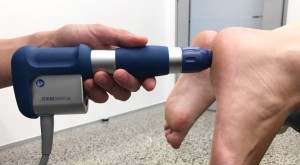Heel pain clinic
Don’t ignore heel pain – get assessed by our specialist podiatrists
One of the most common causes of heel pain is plantar fasciitis
Left untreated, plantar fasciitis or chronic heel pain can last anywhere from a few weeks to years. It causes pain in the soft tissue in the heel and the bottom of the foot. The plantar fascia is a soft tissue structure that helps maintain the shape of the foot and arch by supporting the bones, joints, and muscles for walking.
The good news is shockwave treatment is effective.
Shockwave therapy can treat:
- Plantar heel pain/plantar fasciitis
- Chronic Achilles tendinopathy
- Shin splints
- Patella tendinopathy (jumpers’ knee)
- Neuroma
- Heel spurs
- Insertional pain
- Chronic tendinopathy
- Along with many other musculoskeletal conditions.
Shockwave therapy – it may only take three sessions
Shockwave therapy treats soft tissue injuries, ligaments, and tendons. It’s been used in sports medicine clinics worldwide for several years and is a popular treatment for plantar fascia dysfunction (fasciitis) and insertional Achilles tendinopathy.
Non-invasive, shockwave therapy uses a hand-held device to deliver shockwave impulses for around five minutes each session.
The technical term for shockwave therapy is Extra-corporeal Shock Wave Therapy (ESWT), and scientific evidence has proven it effective for plantar fasciitis with improvement in pain levels after only 3 sessions for over 70% of patients.
Shockwave therapy is a great option compared to the more risky and intrusive cortisone injections and surgeries, with no needles, anaesthetics, or scars to worry about.
 How does shockwave therapy work?
How does shockwave therapy work?
The hand-held device sends shockwaves directly to the injury site identified by your pain levels and your podiatrist assessment. The release of acoustic waves is transmitted through the skin to the damaged tissue, promoting the regeneration and reparative processes of the bones, tendons and surrounding soft tissues.
What to expect
- We locate the area of pain with a hands-on examination of your feet (this is known as palpation).
- We then use a hand-held device to deliver shockwave impulses.
- It takes around five minutes for a single treatment.
- It is generally uncomfortable for the vast majority of our patients rather than painful.
- We repeat this process multiple times (around three to six treatments in total depending on your condition).
- The ideal time between appointments is a week.
- You may notice an immediate improvement; however, the best results occur three months after the first treatment when the tissue has had a chance to regenerate.
Is shockwave therapy right for you?
Please contact us for an appointment with one of our podiatrists. We will thoroughly examine and assess your condition and discuss the treatment options to create a plan tailored to your needs. Often shockwave therapy is useful alongside other podiatrist services such as strapping, orthotics, footwear and stretching advice.
Book now